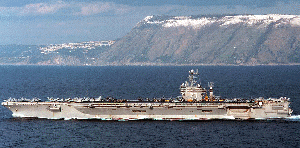CV/CVN (Aircraft Carrier)* |
| The aircraft
carrier's primary mission is to provide a forward-deployed offense.
It accomplishes this by supporting a composite airwing of some
70-plus multimission-capable aircraft.
Combat capabilities include surveillance, antisubmarine warfare, antisurface ship warfare, air-to-air combat, strike warfare, and electronic countermeasures warfare. Supportive missions, including
medical support of the crew members aboard, are facilitated by a
self-sufficient carrier hospital, which is a 65-bed, level
"2-plus" facility with the following attributes:
Carrier manning includes:
The carrier's medical
department also serves as a consultative and primary MEDEVAC facility for
the other vessels within the battle group, which could consist of another
six ships and some 2,000 crewmembers. |
 USS George Washington CVN 73 Aircraft carriers have excellent medical resources, including communications, physical facilities, transportation, and medical staff. Their limitations are:
|
*From Operational Medicine 2001, Health Care in Military Settings, NAVMED P-5139, May 1, 2001, Bureau of Medicine and Surgery, Department of the Navy, 2300 E Street NW, Washington, D.C., 20372-5300
Contents · Introduction · Learning Objectives · Textbook · Lectures · Procedures · Final Exam · Library · Laboratory · Pharmacy · Imaging · Forms · Videos · Search · About the Author · Contact Us
Military Obstetrics & Gynecology
© 2005
Medical Education Division,
Brookside Associates, Ltd.
All rights reserved